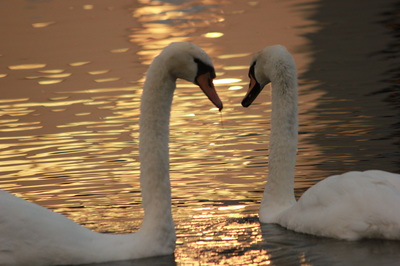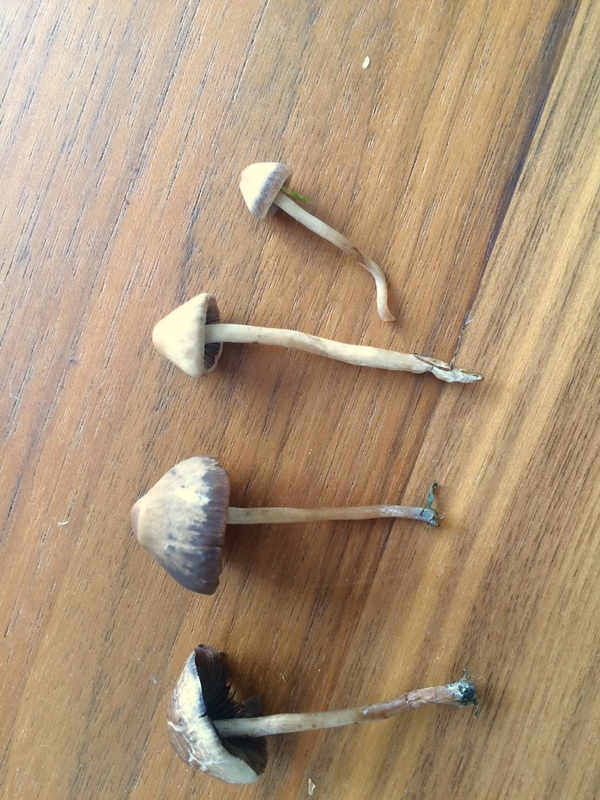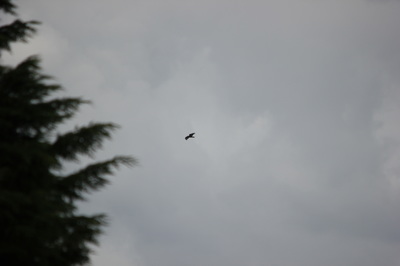|
via Irish Wildlife http://ift.tt/1NiJJhw
via Irish Wildlife http://ift.tt/1NiJJhw
There are over 4000 species of mushroom in Ireland and we know little about a lot of the species ad their properties. There are over 8 species know to cause halluonogenic effect in Ireland and they may have been used by our ancestors to create some hallucinogenic rock art swirls.
Japanese knotweed (Fallopia japonica), is an invasive herbaceous perennial (a plant that can live more than one year). Since it was introduced as an ornamental plant in the 19th Century from Japan, it has spread across the island of Ireland, particularly along watercourses, transport routes and waste grounds where its movement is unrestricted. Japanese knotweed can:
1) Praise, flattery, exaggerated manners and fine, high-sounding words were no part of Lakota politeness. Excessive manners were put down as insincere, and the constant talker was considered rude and thoughtless. Conversation was never begun at once, or in a hurried manner. 2) Children were taught that true politeness was to be defined in actions rather than in words. They were never allowed to pass between the fire and the older person or a visitor, to speak while others were speaking, or to make fun of a crippled or disfigured person. If a child thoughtlessly tried to do so, a parent, in a quiet voice, immediately set him right.
3) Silence was meaningful with the Lakota, and his granting a space of silence before talking was done in the practice of true politeness and regardful of the rule that ‘thought comes before speech.’…and in the midst of sorrow, sickness, death or misfortune of any kind, and in the presence of the notable and great, silence was the mark of respect… strict observance of this tenet of good behavior was the reason, no doubt, for his being given the false characterization by the white man of being a stoic. He has been judged to be dumb, stupid, indifferent, and unfeeling. 4) We did not think of the great open plains, the beautiful rolling hills, the winding streams with tangled growth, as ‘wild’. Only to the white man was nature a ‘wilderness’ and only to him was it ‘infested’ with ‘wild’ animals and ‘savage’ people. To us it was tame. Earth was bountiful and we were surrounded with the blessings of the Great Mystery.
5) Kinship with all creatures of the earth, sky and water was a real and active principle. In the animal and bird world there existed a brotherly feeling that kept the Lakota safe among them. And so close did some of the Lakotas come to their feathered and furred friends that in true brotherhood they spoke a common tongue. 6) This concept of life and its relations was humanizing and gave to the Lakota an abiding love. It filled his being with the joy and mystery of living; it gave him reverence for all life; it made a place for all things in the scheme of existence with equal importance to all. 7) It was good for the skin to touch the earth, and the old people liked to remove their moccasins and walk with bare feet on the sacred earth… the old Indian still sits upon the earth instead of propping himself up and away from its life giving forces. For him, to sit or lie upon the ground is to be able to think more deeply and to feel more keenly. He can see more clearly into the mysteries of life and come closer in kinship to other lives about him.
8) Everything was possessed of personality, only differing from us in form. Knowledge was inherent in all things. The world was a library and its books were the stones, leaves, grass, brooks, and the birds and animals that shared, alike with us, the storms and blessings of earth. We learned to do what only the student of nature learns, and that was to feel beauty. We never railed at the storms, the furious winds, and the biting frosts and snows. To do so intensified human futility, so whatever came we adjusted ourselves, by more effort and energy if necessary, but without complaint. 9) …the old Lakota was wise. He knew that a man’s heart, away from nature, becomes hard; he knew that lack of respect for growing, living things soon led to lack of respect for humans, too. So he kept his children close to nature’s softening influence. 10) Civilization has been thrust upon me… and it has not added one whit to my love for truth, honesty, and generosity. We all record. We record the majority of the significant moments of our lives. The simulacrum is all around us. It appears in our Facebook and our Twitter feeds. We turn the camera on the world.
Professional broadcasters too, record the world around us. The wonder of planet Earth through the professional’s lens and the soothing voice of Sir David Attenburgh is a unique pleasure for the wildlife enthusiast. We are privileged to witness the great wildlife experiences from the comfort of our sofas. Recorded and edited. The wildlife recording/filming has undergone significant progress, in particular, BBC Springwatch has added a new live dimension. The programmes are broadcast live from locations in a primetime evening slot on the BBC. They require a crew of 100 and over 50 cameras, making them the BBC's largest British outside broadcast events. Many of the cameras are hidden and operated remotely to record natural behaviour, for example, of birds in their nests and badgers outside their set. It attempts to record the fledging of chicks, the mischief of the cuckoo and the turn of the natural cycle all live. The BBC has a huge team of producers and technicians to experts and storytellers. They do a remarkable job of it in a small corner of the world be it Minsmere or the Scottish highlands. They capture the macro and the micro worlds of nature as well as the intricate web of species interrelationships. We witness the great wildlife experiences from the comfort of our sofas With the advent of social media.-Twitter to tumblr- amateurs, like me, are given the ability to log and record. Recently, I used the new app, Periscope for the first time. This allows the user to live stream video from their phone. The first views from irishwildlife.ie on Periscope were of the river Nore in Kilkenny. 20 people saw it from all over the world. A river live. Raw and unedited. I was looking for otters or at least signs of otters. Viewers immediately wanted to see the otters. Had I tricked the audience? Had I announced the Loch Ness monster?. Well at least I had focused the minds of my meagre audience. Eyes clued to the scene of a river. Live. There is another aspect of recording. Citizen science presents big data. A real time recording of wildlife events. The public gets involved. We record. This year the BBC has the British public recording the signs of spring through five signatory signs. These testament signs include the leafing oak and the return of the swallow. Here in Ireland, we record the first sighting of basking sharks off our waters indicating the upwelling of plankton. Camera traps have allowed us to leave and to record the behaviour of animal both during the day and at night. Badgers are recorded using GPS tags to prove they avoid farmyards and amazingly fields of grazing cattle. Satellite GPS tags also track golden eagles in Donegal as well as other Eagles as they travel across county boundaries. However, Nature is always live. People have their own expectations. People turn up and want to see an otter or dolphin in high definition detail live. We can watch Attenborough and a snow leopard. But to get that shot, one man took 6 weeks in Afghanistan to capture a fleeting glance of a snow leopard. He spent Christmas Day in a hide attempting to capture some fleeting moments of the elusive creative. Anyone who has ever tried to photograph and otter or a kingfisher in the wild, will surely testify that the reality is unpredictable. Everyone who watches wildlife knows the hours of patient and intelligent scouting that takes place. I saw a kingfisher today. It streaked past me on the banks of the Nore. If I had stayed still I would have set my camera and seen the perch it was on. I reacted enthusiastically and the kingfisher moved out of shot. I waited 25 minutes. I tried to get ahead of the bird. It started to rain as I squatted in the mud under the cover of a tree. I waited. Natural behaviour recording requires knowledge and planning, patience and most of all luck. The wonder of nature is that it is always live. The surprise and the revelation is the wonder. The unpredictability expresses its complexity. Nature is always on. This article originally appeared in The Law Society Gazette in August 2014 and is reproduced here with kind permission from the author Kevin Hoy. Incentives for the use of the countryside are important for our rural economy. In Ireland, there is no common law ‘right to roam’ across land. While we may deal with certain landowner concerns, government intervention is required in respect of issues such as trespass and devaluation of property caused by public rights of way. Rights of way do exist, but the network of public rights of way in Ireland is very limited. The public may claim a right of way over land only if a particular and defined route has been dedicated by specific grant by a landowner and accepted by the public. As I write this i'm about to leap into my car and drive 160km to view a carcass. Sounds wierd? The carcass is that of a killer whale or orca. News filtered out on twitter. As I write this i'm about to leap into my car and drive 160km to view a carcass. Sounds wierd? The carcass is that of a killer whale or orca. News filtered out on twitter.After a help with directions from @mermaidpress, Clare Scott, I turned off the Tramore to Dunmore East road reving in anticipation. I was in a hurry. The gloaming light was perfect for photography The sandy coastline whizzed by. News from @mernaidpress was that the whale was due to be removed by the council by 5pm.
Boom. I hit a pothole. Puncture. Alloy wheel jamed. I cursed my luck and limped back to Tramore. I must praise all the local people who stopped to help. Everyone I met was so firendly and helpful. Cars screeched to a halt to help on their way to see the Orca. People were excited about a whale carcass; A 'beautiful beast. Defeated and a little depressed I returned to Dublin. On the bus I read an Irish times article about the stranding. It seems the carcass was removed for one scientific reason; to do an autopsy. However, I was appalled to discover that a previous whale carcass had been mutilated and stood on. People had carved their names into the side of the cetacean. I wouldn't like to have asked for assistance from those people who acted so disgustingly. The people I met on my long day's journey were kind and considerate: respectful and helpful. As Ghandi said Be the good you want to see in the world The current skeleton of this specimen will be hopefully preserved as a local piece of fabulous flotsam. A special thanks to Clare Scott for directions, help and picture. Please read her wonderful blog at https://mermaidspurse.wordpress.com Patch birding' entails working a familiar route or site on a regular basis, thus gaining an in depth knowledge & feel for the birds that inhabit or pass through it. A patch may constitute any type of habitat with popular choices including coastal walkways or headlands, lakes & marshes, farmland & woodland, suburban parks etc. It's a new year and I have moved patch to the enclave of Booterstown in Sth County Dublin. Inspired by the wonderful book 'A Place Near Heaven' by Damien Enright I have decided to embark on a spot of patch birding.
Convieniently right on my doorstep is Booterstown reserve. Up to this point I have travelled around Ireland capturing some amazing Irish wildlife events. This year I am adding some depth to my wildlife exposure. I am looking forward to witnessing the changes that occur over a full year on my local patch. I feel this will be an interesting project both scientifically, socially and spiritually. The Booterstown Nature Reserve is a sanctuary for wildlife, and is an unusual little piece of wilderness within the confines of the City of Dublin, Ireland. The Reserve is situated on the edge of Dublin Bay, about 6 km south-east of Dublin city centre. Sandwiched between the main road and the Dublin Area Rapid Transport (DART) railway line, it covers an area of just 4 hectares, and is the only salt marsh nature reserve in Dun Laoghaire-Rathdown County. The elevated surroundings of the marsh make it particularly suitable for the study of wildlife, especially birds, without causing any disturbance to the feeding flocks. More information about the sites history can be found here http://www.friendsofbooterstown.ie/index.htm Recently I received a copy of this wonderful book from an old college friend aimed at inspiring a new generation of wildlife lovers. If you have young kids in your clan they will surely love this book. It is a visual feast of Irish Wildlife. Please find information on how to buy it below. ’My First Book of Irish Animals’ is a beautiful picture book to introduce young children to our wonderful wildlife. Filled with fascinating facts and illustrated by Aoife Quinn, a very talented Irish artist, this unique book will capture the imagination of young children. About the Author/Publisher: Juanita Browne’s books include ‘Ireland’s Mammals’ (2005); ‘Kildare’s Natural Heritage’ (2008), and ‘Put the Kettle On - the Irish love affair with tea’ (2013). She currently works on natural history productions for television and radio. Having taken out my girlfriend's Christmas decorations from storage I discovered revealed two Scandinavian druidlikemen accompanied by a fly Agaic mushroom. This got me thinking about how this iconic mushroom appears in our cultural anthropology. After all for most people. this is the quintessential toadstool. How did we relate as a people to this example of Irish wildlife?
One wonderful festive link is that the red and white of Santa Clauses coat has been linked to the colours of the mushroom. This tentative link is a nice idea in isolation. More prevalent in modern day ,The most obvious example of this magic mushroom in the media is from the Supermario game or watching the TV series the smurfs. However I wanted to find an earlier and more primal link between our islands culture and this beautiful toadstool. In Irish folklore, the species has been associated with a notion of 'Celtic' Druidism. Druids were said to fast for 3 days before taking this mushroom. Part of the poisonous effect was to cause stomach cramps and therefore expel any water or food. The psychoactive active substance then took effect bringing on hallucinations. This is not advised for a modern advocate,but it does show the deep link we have with this little fungus. The research continues. Dear Recorder,
I am delighted to let you know that this week the 5,000th mammal record was submitted to the Atlas Of Mammals in Ireland 2010-2015 project. This was a sighting of a red fox at Stillorgan, Dublin. Attached is a summary density map of all the terrestrial records that have been submitted to the project over the last 18 months. The objective of the Atlas of Mammals of Ireland is to collate sightings of mammals to produce comprehensive distribution maps of all mammals in Ireland over the 5-year period 2010 to 2015. This information will be used to supplement the existing sightings databases compiled by some researches, NGOs such as Bat Conservation Ireland and Irish Whale and Dophin Group and the statutory agencies, NPWS and NIEA. To date, this collation exercise has brought together almost 100,000 mammal records for the island of Ireland and it marine waters http://mammals.biodiversityireland.ie/ . The intention is to publish a hard copy Atlas of Mammals in Ireland after 2015 - so there are just over two years remaining in this data collection phase. While huge progress has been made in receiving mammal sightings, you will see from the attached map that there are still many parts of the country from which we are receiving very few sightings. So please continue to submit sighting to the Atlas of Mammals in Ireland project http://records.biodiversityireland.ie/submit_records.php?fk=MammalsStandard&caching=cache and if you know anyone living in some of the under-recorded areas, I would be extremely grateful if you could bring this project to their attention. Thank you, and I look forward to notifying you when we reach the 10,000th record milestone! Very best wishes, Liam |
Archives
July 2018
Categories
All
Archives
July 2018
|
| Irish Wildlife | Blog |



















































































